Statistical Commentary
Published 28 July 2022
About this release:
This release includes statistics on Challenges made by taxpayers (or their representatives) against the 2017 local rating list up to 30 June 2022. It also includes statistics on reviews of rating assessments (known as “reports”) that have either been initiated by the Valuation Office Agency (VOA) or a Billing Authority, when new information becomes available.
These statistics do not include the number of appeals made under the Check, Challenge, Appeal (CCA) system because these are the responsibility of the independent Valuation Tribunal Service (VTS), however, the VTS publish their latest statistics on their website.
Responsible Statistician:
Anna McReady
Statistical enquiries:
Date of next publication:
October 2022
1. Headline figures
1.1 Checks and Challenges against the 2017 Non-domestic Rating List for England at 30 June 2022:
The total number of Checks registered in England under the Check, Challenge, Appeal (CCA) system was
669,200
The total number of Challenges registered in England under the Check, Challenge, Appeal (CCA) system was
126,010
It is estimated that 55,560 of these challenges were made as a result of Covid-19 restrictions being imposed
In addition:
-
659,910 checks have been resolved
-
99,330 challenges have been resolved; of these, an estimated 51,550 were related to Covid-19 restrictions being imposed
-
14,850 challenges have been marked as incomplete; of these, an estimated 4,010 were related to Covid-19 restrictions being imposed
-
226,920 Interested Persons (IPs) and 17,060 agents had registered to use the check and challenge service
-
the VOA have approved 641,320 property claims by businesses
1.2 Checks and Challenges against the 2017 Non-domestic Rating List for England from 1 April to 30 June 2022:
The number of Checks registered in England from 1 April to 30 June 2022 was
22,560
Up from 21,590 in the previous quarter (1 January to 31 March 2022)
The number of Challenges registered in England from 1 April to 30 June 2022 was
4,240
Down from 4,680 in the previous quarter
In addition, from 1 April to 30 June 2022 the VOA resolved 21,690 checks (up from 20,810) and 2,830 challenges (down from 3,950).
1.3 Challenges against the 2017 Non-domestic Rating List for Wales from 1 April to 30 June 2022:
The number of challenges registered in Wales from 1 April to 30 June 2022 was
560
Down from 580 in the previous quarter
The number of challenges resolved in Wales from 1 April to 30 June 2022 was
7,870
Up from 3,120 in the previous quarter
The number of challenges outstanding in Wales at 30 June 2022 was
12,820
Down from 20,130 in the previous quarter
1.4 Appeals outstanding from the 2010 Non-domestic Rating List for England and Wales at 30 June 2022:
The number of appeals outstanding for the 2010 list at 30 June 2022 was
6,920
Down from 8,710 at 31 March 2022
These include those awaiting listing, relisting or decisions from the Valuation Tribunal, which the VOA do not control, and also some highly complex cases relating to specialist properties where a longer time frame is necessary to settle the appeals.
2. Checks, Challenges and Changes against the England 2017 Rating List
There was a spike in the use of VOA services during the Covid-19 pandemic, which is reflected in the statistics shown in this release.
Before anyone can access more detailed valuation data about a property, they must prove that they have a legal interest in the property under the non-domestic rating legislation, for example, as an owner or occupier or both. To do this, they are required to register to use the CCA system and then can ‘claim their property’ through the VOA’s online service by providing proof of their relationship to the property, such as a copy of a business rates or utility bill. Once the VOA confirm the interested person’s relationship to the property, the claim is approved, and the interested person is able to view or request the detailed valuation for that property. The interested party can then start the CCA process. More information is available on GOV.UK.
Figure 1: Customer registrations by customer type and month, 1 Apr 2017 to 30 June 2022
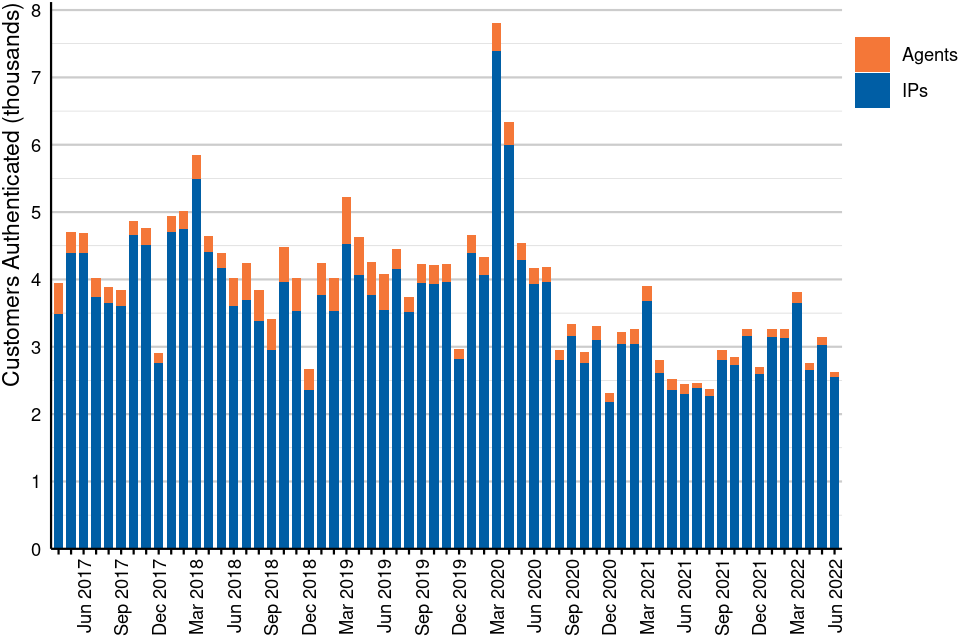
Figure 1: Customer registrations by customer type and month, 1 Apr 2017 to 30 June 2022
Source: Checks, Challenges and Changes against the 2017 Local Rating List, England (Table 1.2)
The number of interested persons (IPs) and agents registering for CCA each month is shown in Figure 1. More than 90% of registrations are from interested persons rather than agents.
A seasonal pattern is visible in the graph; registrations are relatively high at the start of the year and gradually decrease as the year goes on. In March and April 2020 there were 14,140 registrations, which is a spike attributable to the Covid-19 pandemic. Since then, the number of registrations has steadily decreased.
Figure 2: Approved property claims by month, 1 Apr 2017 to 30 June 2022

Figure 2: Approved property claims by month, 1 Apr 2017 to 30 June 2022
Source: Checks, Challenges and Changes against the 2017 Local Rating List, England (Table 1.3)
The number of approved property claims by month is shown in Figure 2. The spike due to Covid-19, which totaled 59,730 approved property claims, was in May and June 2020. The difference from the March and April 2020 spike shown in Figure 1 reflects the time it takes for a customer registering for CCA to claim a property and then have their claim approved by a Valuation Officer.
Figure 3: Checks against the England 2017 NDR List by case status and month, 1 Apr 2017 to 30 June 2022

Figure 3: Checks against the England 2017 NDR List by case status and month, 1 Apr 2017 to 30 June 2022
Source: Checks, Challenges and Changes against the 2017 Local Rating List, England (Tables 2.1 and 2.2)
Figure notes: [1] England was in national lockdown between late March and June 2020; [2] From 5 November to 2 December 2021, national restrictions were reintroduced in England; [3] National restrictions were reintroduced for a third time on 6 January 2021; [4] On 8 March 2021, England began a phased exit from lockdown. More information about the history of Covid-19 restrictions in England is available on the House of Commons Library website.
Figure 3 shows the number of checks received by month and case status. Each of the spikes in mid-2020 and November 2020 to February 2021 is attributable to the Covid-19 pandemic and coincided with Government-imposed restrictions on business; see figure notes.
Figure 4: Challenges against the England 2017 NDR List by case status and month, 1 Apr 2017 to 30 June 2022

Figure 4: Challenges against the England 2017 NDR List by case status and month, 1 Apr 2017 to 30 June 2022
Source: Checks, Challenges and Changes against the 2017 Local Rating List, England (Tables 2.1 and 2.2)
Figure 4 shows the number of CCA Challenges received by month and case status. The month with the highest number of Challenges received was August 2020, when the VOA received 22,330 Challenges; this was a consequence of the prior rise seen in Checks (figure 3) and is attributable to the Covid-19 pandemic. The VOA resolved 52,490 Challenges in December 2020, a figure which is around 30 times the average number of Challenges resolved in all previous months. This is due to Covid-19 Challenges being resolved in bulk following the enactment of the Rating (Coronavirus) and Directors Disqualification (Dissolved Companies) Act 2021. For further details please refer to Non-domestic Rating: Challenges and Changes, 2017 Rating List, March 2022.
Figure 5: Resolved CCA cases by case type and outcome against the England 2017 NDR List, 1 Apr 2017 to 30 June 2022
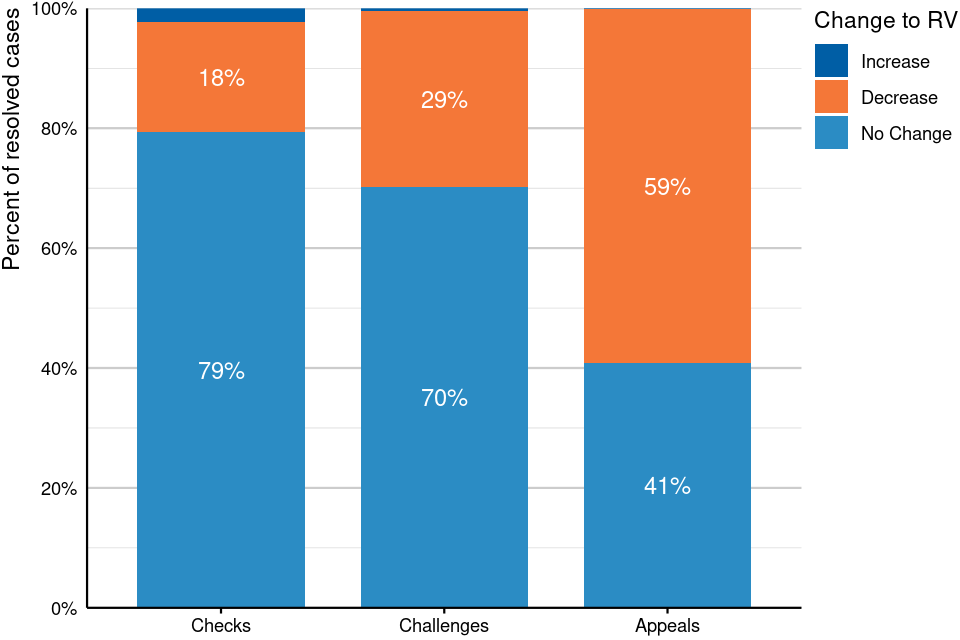
Figure 5: Resolved CCA cases by case type and outcome against the England 2017 NDR List, 1 Apr 2017 to 30 June 2022
Source: Checks, Challenges and Changes against the 2017 Local Rating List, England (Table 3.1)
Table 1: Resolved CCA cases by case type and outcome against the England 2017 NDR List, 1 Apr 2017 to 30 June 2022
| Case type | Increase | Decrease | No Change |
| Checks | 14,680 | 121,070 | 524,160 |
| Challenges | 430 | 29,140 | 69,750 |
| Appeals | – | 680 | 470 |
Source: Checks, Challenges and Changes against the 2017 Local Rating List, England (Table 3.1)
Table notes: Counts are rounded to the nearest 10 with counts fewer than 5 reported as negligible and denoted by ‘–’
Figure 5 and table 1 show breakdowns for the outcome (change to rateable value (RV)) of resolved CCA cases by case type. The highest percentage of cases resulting in no change to the RV was in Checks, with 79 per cent (524,160 cases), followed by Challenges (70 per cent, 69,750 cases) and then Appeals (41 per cent, 470 cases). For cases resulting in an RV decrease, the highest percentage was in Appeals, with 59 per cent (680 cases), followed by Challenges (29 per cent, 29,140 cases) and then Checks (18 per cent, 121,070 cases). Cases resulting in an RV increase made up 2 per cent of Checks, less than one per cent of Challenges and less than 0.1 per cent of Appeals.
Figure 6: Resolved CCA Checks by region and outcome against the England 2017 NDR List, 1 Apr 2017 to 30 June 2022
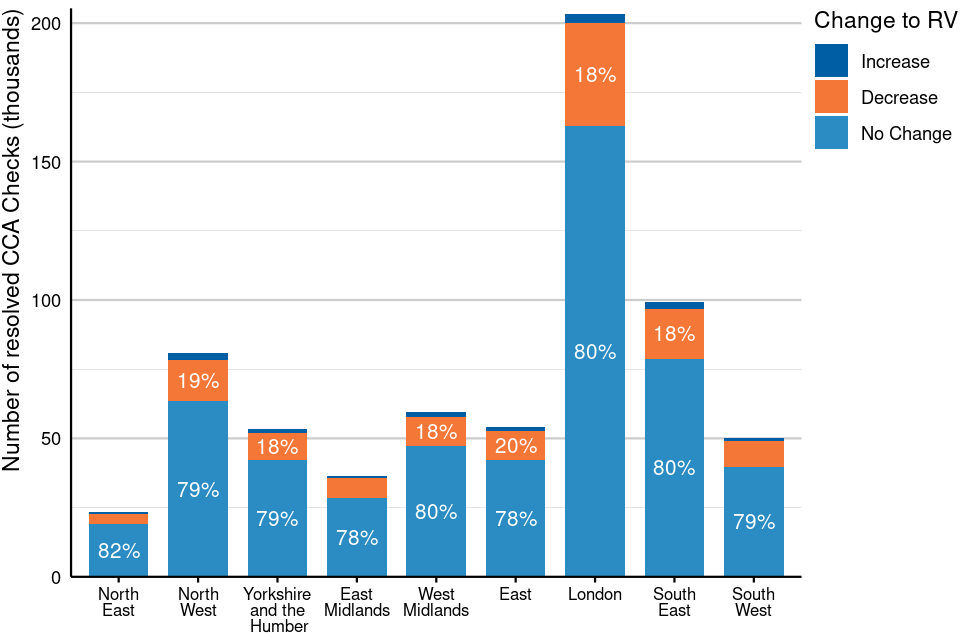
Figure 6: Resolved CCA Checks by region and outcome against the England 2017 NDR List, 1 Apr 2017 to 30 June 2022
Source: Checks, Challenges and Changes against the 2017 Local Rating List, England (Table 3.1)
Figure notes: Please note that the percentage labels in most of the bars are only displayed for the outcomes of ‘No change’ and ‘Decrease’. Therefore, the percentages will not sum to 100% for each region.
Table 2: Resolved CCA Checks by CCA case type and outcome against the England 2017 NDR List, 1 Apr 2017 to 30 June 2022
| Region | Increase | Decrease | No Change |
| North East | 560 | 3,690 | 19,180 |
| North West | 2,370 | 14,980 | 63,370 |
| Yorkshire and the Humber | 1,430 | 9,790 | 42,140 |
| East Midlands | 900 | 7,060 | 28,510 |
| West Midlands | 1,540 | 10,580 | 47,280 |
| East | 1,150 | 10,610 | 42,200 |
| London | 3,150 | 37,170 | 163,020 |
| South East | 2,370 | 17,890 | 78,850 |
| South West | 1,220 | 9,290 | 39,630 |
Source: Checks, Challenges and Changes against the 2017 Local Rating List, England (Table 3.1)
Table notes: Counts are rounded to the nearest 10
Figure 6 and table 2 show the number of resolved CCA Check cases by geographical region and their outcome. The distribution of Check cases resulting in no change to RV, RV decreases and RV increases was fairly uniform across all of the regions; the outcome of no change to RV ranged between 78 per cent to 82 per cent.
Figure 7: Resolved CCA Challenges by region and outcome against the England 2017 NDR List, 1 Apr 2017 to 30 June 2022
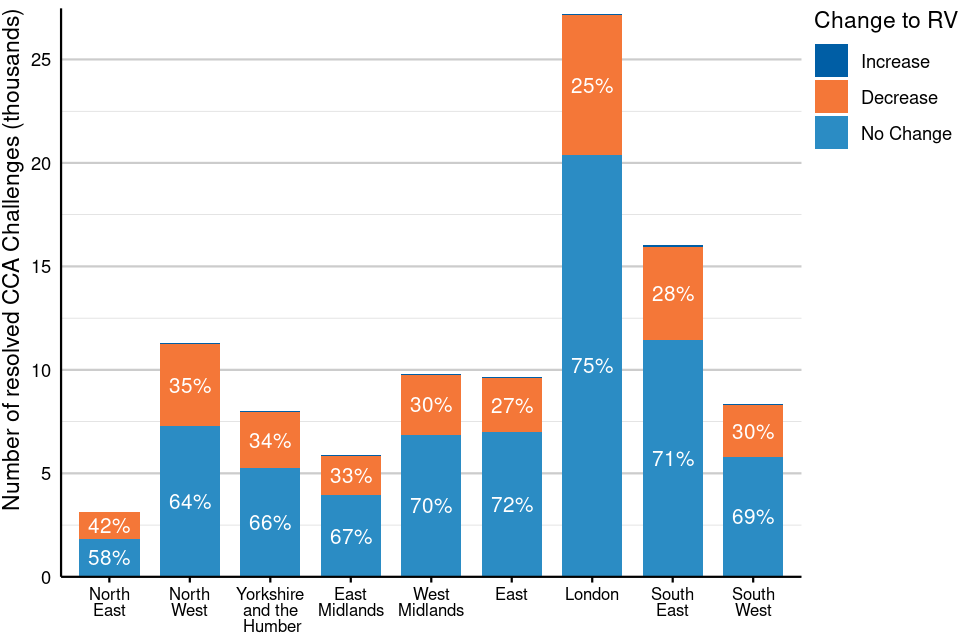
Figure 7: Resolved CCA Challenges by region and outcome against the England 2017 NDR List, 1 Apr 2017 to 30 June 2022
Source: Checks, Challenges and Changes against the 2017 Local Rating List, England (Table 3.1)
Figure notes: Please note that the percentage labels are only displayed for the outcomes of ‘No change’ and ‘Decrease’. Therefore, the percentages will not sum to 100% for each region.
Table 3: Resolved CCA Challenges by CCA case type and outcome against the England 2017 NDR List, 1 Apr 2017 to 30 June 2022
| Region | Increase | Decrease | No Change |
| North East | 10 | 1,310 | 1,830 |
| North West | 60 | 3,960 | 7,270 |
| Yorkshire and the Humber | 40 | 2,700 | 5,250 |
| East Midlands | 30 | 1,910 | 3,940 |
| West Midlands | 40 | 2,910 | 6,850 |
| East | 30 | 2,620 | 6,990 |
| London | 80 | 6,750 | 20,380 |
| South East | 100 | 4,490 | 11,460 |
| South West | 50 | 2,500 | 5,790 |
Source: Checks, Challenges and Changes against the 2017 Local Rating List, England (Table 3.1)
Table notes: Counts are rounded to the nearest 10
Figure 7 and table 3 show the number of resolved CCA Challenge cases by geographical region and their outcome. For Challenges, the outcome of no change to RV ranged from 58 per cent in the North East to 75 per cent in London.
Figure 8: Resolved CCA Appeals by region and outcome against the England 2017 NDR List, 1 Apr 2017 to 30 June 2022
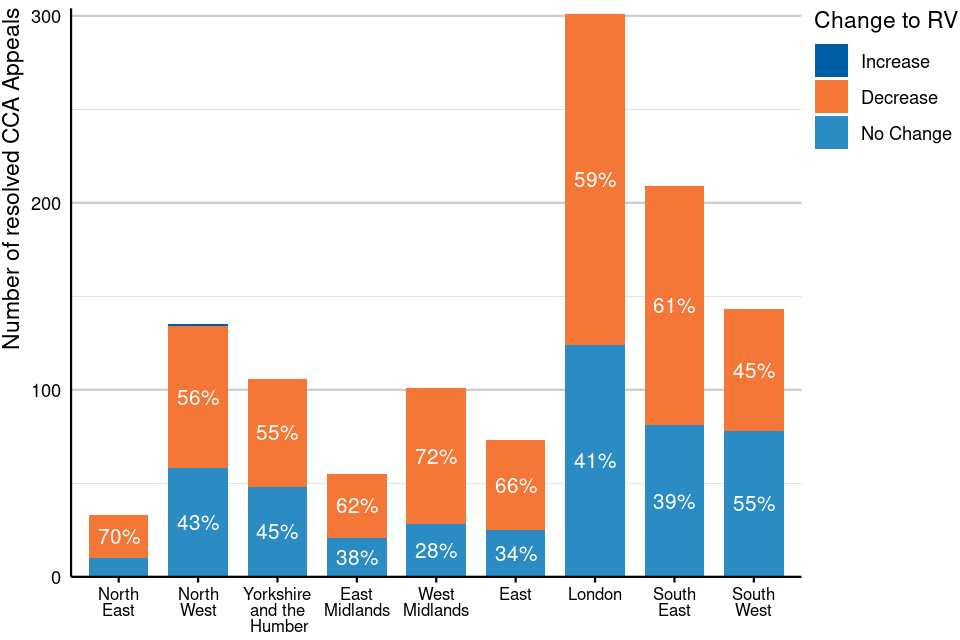
Figure 8: Resolved CCA Appeals by region and outcome against the England 2017 NDR List, 1 Apr 2017 to 30 June 2022
Source: Checks, Challenges and Changes against the 2017 Local Rating List, England (Table 3.1)
Figure notes: Please note that the percentage labels in most of the bars are only displayed for the outcomes of ‘No change’ and ‘Decrease’. Therefore, the percentages will not sum to 100% for each region.
Table 4: Resolved CCA Appeals by CCA case type and outcome against the England 2017 NDR List, 1 Apr 2017 to 30 June 2022
| Region | Increase | Decrease | No Change |
| North East | 0 | 20 | 10 |
| North West | – | 80 | 60 |
| Yorkshire and the Humber | 0 | 60 | 50 |
| East Midlands | 0 | 30 | 20 |
| West Midlands | 0 | 70 | 30 |
| East | 0 | 50 | 30 |
| London | 0 | 180 | 120 |
| South East | 0 | 130 | 80 |
| South West | 0 | 70 | 80 |
Source: Checks, Challenges and Changes against the 2017 Local Rating List, England (Table 3.1)
Table notes: Counts are rounded to the nearest 10 with counts of 0 being reported as 0 and counts fewer than 5 reported as negligible and denoted by ‘–’
Figure 8 and table 4 show the number of resolved CCA Appeal cases by geographical region and their outcome. For Appeals, the outcome of no change to RV ranged between 28 per cent in the West Midlands to 55 per cent in the South West.
Figure 9: Assessment Reviews against the England 2017 NDR List by case status and quarter, 1 Apr 2017 to 30 June 2022
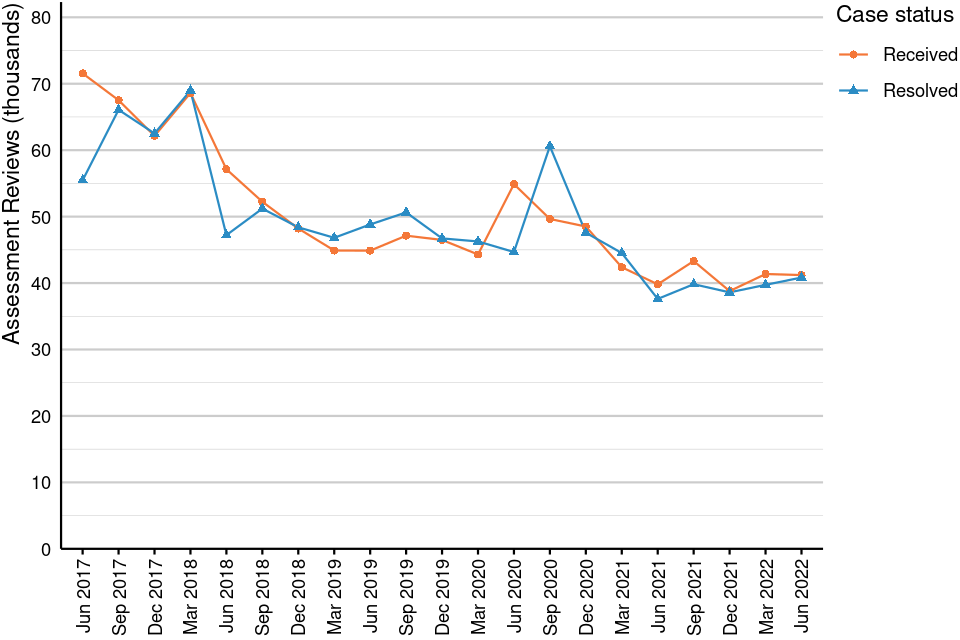
Figure 9: Assessment Reviews against the England 2017 NDR List by case status and quarter, 1 Apr 2017 to 30 June 2022
Figure 9 shows that the number of assessment reviews received and resolved against the England 2017 list. In general, the trend shows that the number of assessment reviews has been decreasing since the start of the list; however, there was a brief spike in 2020, likely due to the Covid-19 pandemic.
3. Challenges and Changes against the Wales 2017 Rating List
For Wales, a challenge is defined as a proposal by the ratepayer to alter the rating list; typically attributable to a challenge to the assessed rateable value or a change of circumstance of the property as well as physical changes in the locality.
Figure 10: Challenges against the Wales 2017 NDR List by case status and quarter, 1 Apr 2017 to 30 June 2022
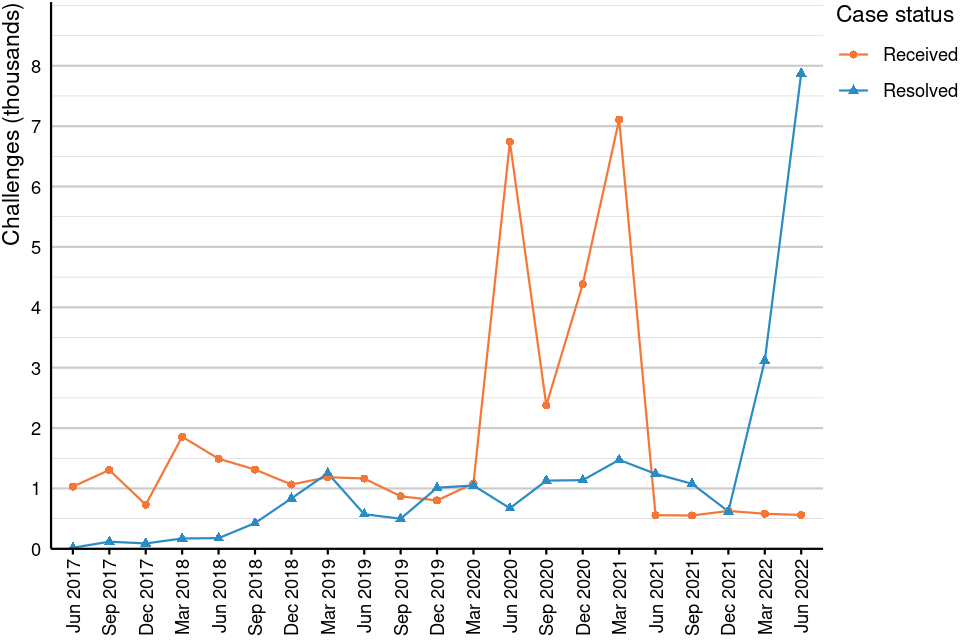
Figure 10: Challenges against the Wales 2017 NDR List by case status and quarter, 1 Apr 2017 to 30 June 2022
Source: Challenges and Changes against the 2017 Local Rating List, Wales (Tables 1.1 and 1.2)
Figure 10 shows that the 560 challenges received against the Wales 2017 list in the quarter to 30 June 2022 was the among the lowest on record; the number of challenges received in Wales has been consistently low since the quarter to June 2021. The VOA resolved 7,870 Challenges in the quarter to 30 June 2022, the highest to date.
In Wales, 23,860 challenges were received between 1 March 2020 and 30 June 2022, approximately 16,490 of which were related to Covid-19 restrictions. The Rating (Coronavirus) and Directors Disqualification (Dissolved Companies) Act 2021 states that measures brought in as a result of coronavirus will not be considered a Material Change of Circumstances (MCC). This means that Challenges in England and Wales based on the effect of these measures will not see a change in rateable value. The VOA are contacting ratepayers in Wales and asking them to withdraw their cases, which results in no change to rateable value. At 30 June 2022, 9,910 of these challenges had been withdrawn.
Figure 11: Assessment Reviews against the Wales 2017 NDR List by case status and quarter, 1 Apr 2017 to 30 June 2022
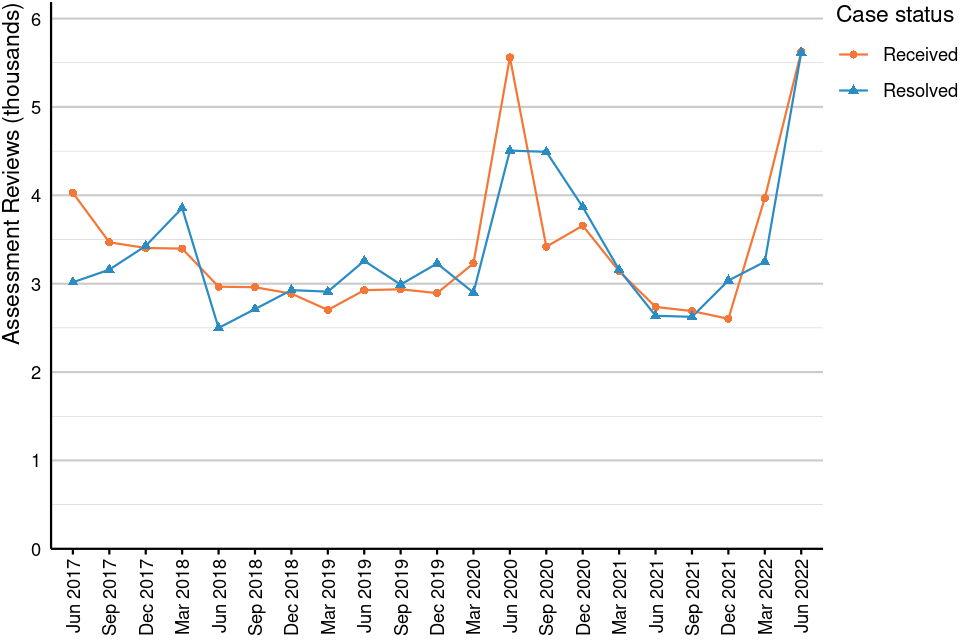
Figure 11: Assessment Reviews against the Wales 2017 NDR List by case status and quarter, 1 Apr 2017 to 30 June 2022
Source: Challenges and Changes against the 2017 Local Rating List, Wales (Tables 3.1 and 3.2)
Figure 11 shows that the number of assessment reviews received and resolved against the Wales 2017 list were both the highest on record in the quarter to 30 June 2022; there were 5,620 reports received and also 5,620 resolved. This increase is the result of a review of self-catering properties in Wales for the purpose of Revaluation 2023. The issuing of the forms of return commenced in April 2021 with the review undertaken between January and April 2022. A report is raised for each property to be reviewed; if it is found that the property does not meet the criteria to be classed as self-catering a further report is raised to move it out of Rating and into the Council Tax list. A two-yearly rolling review of self-catering properties in Wales commenced in June 2022.
4. Background Notes
This release includes statistics on challenges made by taxpayers (or their representatives) against the 2017 local rating list. It also includes statistics on reviews of rating assessments (known as reports) that have either been initiated by the VOA or a billing authority, when new information becomes available. Previous quarters’ figures include retrospective changes so will not necessarily be the same as those from previous publications.
Figures in the release note may be rounded to a different level of accuracy from the figures in the MS Excel tables and should therefore be considered more definitive.
The statistics are derived from VOA’s administrative database and are published at national, regional and billing authority level.
The VOA is required, by the Local Government Finance Act 1988, to compile and maintain accurate rating lists specifying a rateable value for all non-domestic rateable properties in England and Wales. These rateable values provide the basis for national non-domestic rates bills, which are issued by billing authorities. There is a local rating list for each billing authority. However, for simplicity, we have referred to these throughout this publication as one combined ‘rating list’ for those local lists effective from 1 April 2010, and, likewise, one combined ‘rating list’ for those local rating lists effective from 1 April 2017.
Ratepayers, owners, and in limited circumstances, relevant authorities and other persons (known formally as Interested Persons) can make a challenge to alter the rating list if they think an entry is incorrect. Challenges can also be made on behalf of interested persons by their professional representatives.
The process for challenging the rating list currently differs between England and Wales. In Wales a challenge, known as a proposal, is made to the Valuation Officer asking them to change the entry in the rating list. After a period of discussion if the Valuation Officer cannot reach agreement with the ratepayer the matter will then be referred to the Valuation Tribunal Service, at which stage it becomes an appeal. In England a new three stage appeals system was introduced in 2017, called Check, Challenge, Appeal (CCA).
More information about CCA can be found in the Background Information document.
5. Further Information
More detailed information on the 2017 local rating list is available at gov.uk/correct-your-business-rates
Further information on the area codes used in this can be found on the ONS website
More information on statistics at the VOA can be found on the Agency’s website: About VOA statistics
Timings of future releases are regularly placed on the VOA research and statistics calendar
We will keep the format of this document under review to continue improving the presentation of our statistics, and welcome feedback from users on the value of the information provided in this commentary – please forward any comments to the Statistics Inbox
